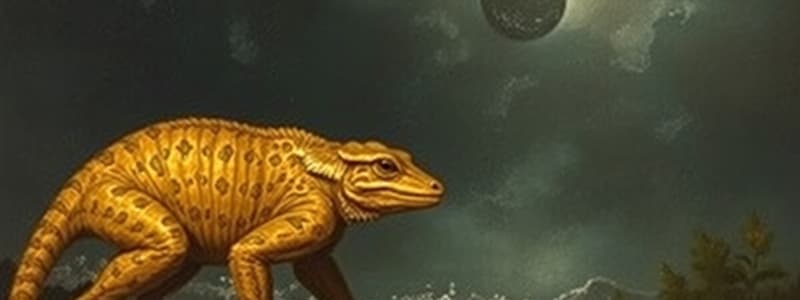Podcast
Questions and Answers
What characteristic distinguishes vertebrates from other animal groups?
What characteristic distinguishes vertebrates from other animal groups?
- Capability of living both on land and in water
- Possession of a backbone or spinal column (correct)
- Being able to adapt to all types of environments
- Having a varied diet that includes both plants and animals
Which evolutionary trait is NOT associated with vertebrates?
Which evolutionary trait is NOT associated with vertebrates?
- Independent evolution of flight among different groups
- Adaptation to diverse habitats
- The ability to fly powered by wings
- Development of complex social structures (correct)
How many times did powered flight evolve independently among vertebrates?
How many times did powered flight evolve independently among vertebrates?
- Four times, including an unknown group
- Twice, in birds and bats
- Once, in birds
- Three times, in pterosaurs, birds, and bats (correct)
What is the significance of comparative biology in studying vertebrates?
What is the significance of comparative biology in studying vertebrates?
What is the evolutionary origin of vertebrate wings?
What is the evolutionary origin of vertebrate wings?
Which statement accurately reflects the evolutionary history of vertebrates?
Which statement accurately reflects the evolutionary history of vertebrates?
In what ways did vertebrate wings develop across different lineages?
In what ways did vertebrate wings develop across different lineages?
What does comparative biology focus on in the study of vertebrates?
What does comparative biology focus on in the study of vertebrates?
Which statement about vertebrate adaptations is true?
Which statement about vertebrate adaptations is true?
Which of the following environments are vertebrates NOT commonly found in?
Which of the following environments are vertebrates NOT commonly found in?
Flashcards are hidden until you start studying
Study Notes
Vertebrate Diversity
- Vertebrates are highly successful, with over 70,000 recognized species.
- They inhabit diverse environments including oceans, land, and air.
- Vertebrate diversity is reflected in their varied body plans and adaptations.
Vertebrate Evolution
- Vertebrates have a long evolutionary history.
- Vertebrates are one of two groups to evolve powered flight.
- Powered flight evolved independently three times in vertebrates: in pterosaurs, birds, and bats.
Comparative Biology
- Comparative biology examines biological structures and their functions across species.
- It helps us understand the role of natural selection, adaptation, evolution, and common ancestry in shaping biological diversity.
- Vertebrate wings, despite evolving independently, are derived from the same structure: the forelimbs.
Vertebrate Diversity
- Vertebrates are a diverse group of animals.
- There are approximately 70,000 recognized vertebrate species.
- Vertebrates have adapted to live in oceans, on land, and in the air.
- This diversity reflects their varied body plans and adaptations.
Vertebrate Evolutionary History
- Vertebrates have a long evolutionary history.
- Vertebrates are one of only two groups to evolve powered flight, the other being insects.
- Powered flight evolved independently three times in vertebrates: pterosaurs, birds, and bats.
- Comparative biology involves comparing biological structures and functions across species.
- This helps understand the role of natural selection, adaptation, evolution, and common ancestry in shaping the diversity of biological structures.
- Vertebrate wings evolved independently from the same structure, the forelimbs.
Studying That Suits You
Use AI to generate personalized quizzes and flashcards to suit your learning preferences.




